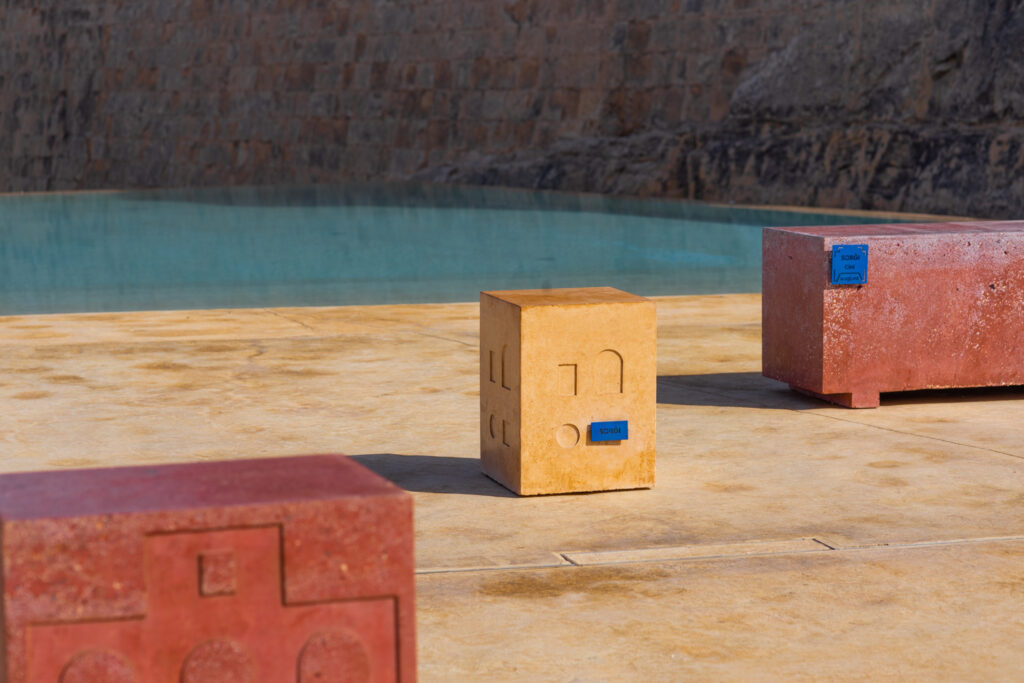SORĠI is an invitation to take a seat and understand the world around us. In Maltese, the word means ‘sit’, but denotes positioning, in a careful manner, almost purposeful, as if one is being anchored. In practical terms, AHA objects’ SORĠI is an outdoor furniture collection for public spaces, a first out of many works in this vein. But beyond that, it is a direct criticism of the booming construction industry: this collection reclaims and repurposes the public space stolen by the construction frenzy by recycling waste (mainly, limestone) generated by the same industry. These six benches each represent a building that has been affected – if not completely lost, in some cases – by the local construction frenzy and the booming industry that stand as a memento of today’s choices and a suggestion for tomorrow’s actions.
The outlook of SORĠI, however, is hopeful and full of potential. The public is empowered, to question the current developments and their social and historic impacts while also imagining an alternative future, where the world can prosper holistically.
The Design
Through the design, every piece conveys the story of the building that inspired it. The design process included 2D and 3D modelling for concept design and detailing. Through interactive labels, the pieces invite the user to delve into an online database of information about Maltese architectures that were (or will be) swept away by the current construction craze: Ta’ Rita (Ghar Lapsi); Roxy Cinema (Birkirkara); Sun City Palais (Marsaskala); Marsa seafront; Twin 19th Century houses (Spinola Bay); and Dolores (Zejtun). The colour, texture, and material of the benches are inspired from the building ‘waiting-to-be-demolished’.
The Making
The choice of materials was informed by the buildings inspiring the collection. Several materials were considered and tested, including discarded fragments of glass, recycled concrete and marble offcuts. Limestone was eventually chosen for several pieces because of its availability, and, structural and aesthetic qualities. The choice is also symbolic, as most of the architecture being demolished is made of this local material.
The prototyping and production phases involved collaborations with local craftsmen and utilised traditional production methods and local resources. Natural pigments, for example, were tested as a way of adding colour and creating extraordinary textures, enhancing the ‘uniqueness’ of each bench.
As part of the making process, 3D printing was used to create the original model, from which the mould for the stool “Dolores” was shaped. In other instances, laser-cutting was employed as part of the mould creation. The rubber shapes that were fabricated through this process allowed the creation of a pattern on some benches like “Emma”.
The Studio
AHA objects is an emerging design studio founded by Anna Horváth in Malta.
The basis of the studio are storytelling, sustainability, and joy, with narratives expressed in the form of exhibition design (Identity Design, Cromwell Place), set design (Ziguzajg), retail experience (Te fit-Tazza Showroom) and furniture collections (Collezione L!Puff).
Understanding the environmental damage that has been done to our planet, the studio fights for sustainability and a circular economy. The team designs and produces furniture made of sustainable materials, including their latest body of work: SORĠI, the outdoor furniture collection recycling construction waste.
Play is a crucial part of AHA’s design methodology leading to joyful colours, shapes and design solutions. In contrast to the playful approach, there is often a hidden social, cultural, environmental or political commentary embedded in the projects.



